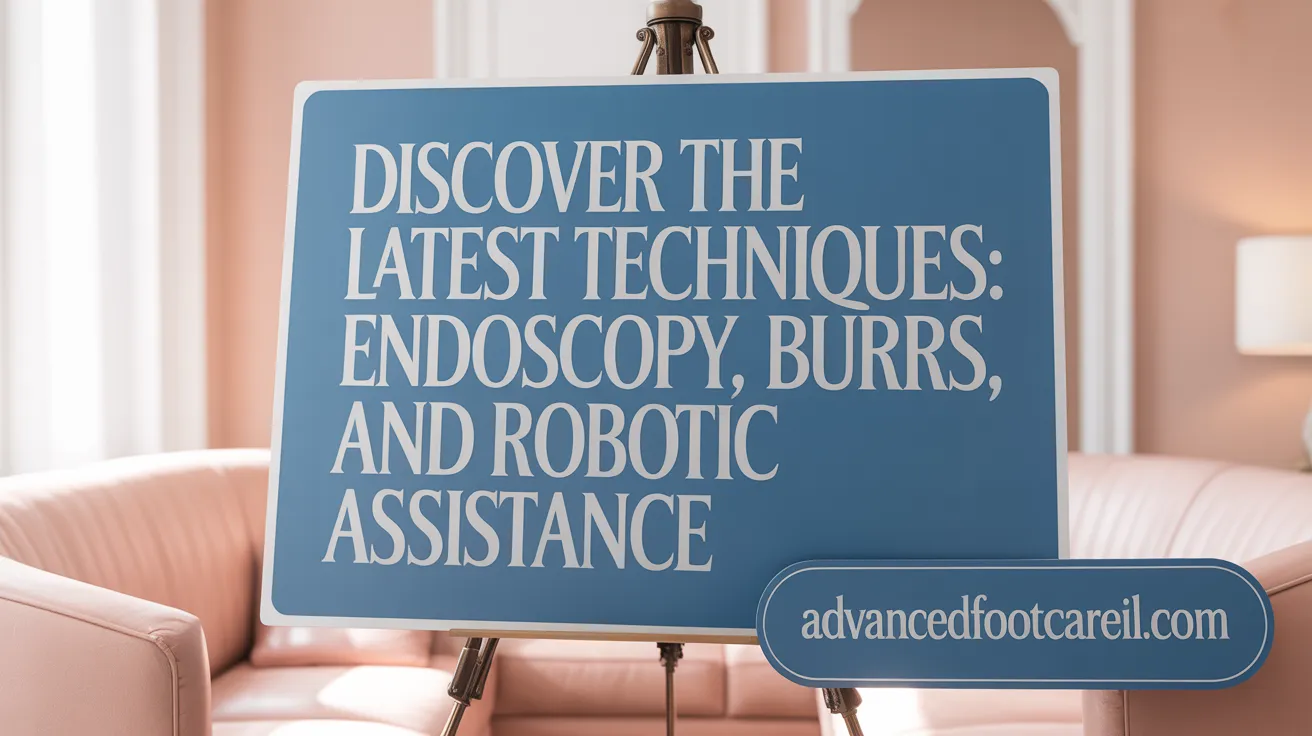Understanding Minimally Invasive Foot Surgery
Minimally invasive foot surgery (MIS) is reshaping how foot and ankle conditions are treated, promising smaller incisions, reduced pain, and faster recovery compared to traditional open surgeries. By utilizing advanced imaging and specialized instruments, these techniques are tailored to minimize tissue damage while maintaining effective correction of various foot ailments. This article explores the benefits, techniques, patient outcomes, and considerations surrounding minimally invasive foot surgery, providing patients with an informed overview to aid decision-making.
General Benefits and Patient Advantages of Minimally Invasive Foot Surgery
 Minimally invasive foot surgery provides numerous advantages over traditional open surgeries. One of its primary benefits is the use of smaller incisions, typically less than 5 millimeters, which significantly reduces damage to surrounding soft tissues and blood vessels. This minimizes pain, swelling, and the formation of scar tissue, resulting in better cosmetic outcomes.
Minimally invasive foot surgery provides numerous advantages over traditional open surgeries. One of its primary benefits is the use of smaller incisions, typically less than 5 millimeters, which significantly reduces damage to surrounding soft tissues and blood vessels. This minimizes pain, swelling, and the formation of scar tissue, resulting in better cosmetic outcomes.
Patients often experience faster recovery times, allowing them to return to daily activities, work, and sports sooner. Many procedures can be performed on an outpatient basis, sometimes even in a doctor's office, which decreases hospital stays and minimizes disruption to the patient’s life.
Postoperative pain is generally lower in minimally invasive techniques, thanks to less tissue trauma. Additionally, the risk of wound infections and healing problems is reduced because the smaller wounds are less prone to complications.
Patients with higher risk factors, such as diabetes or compromised healing capacity, particularly benefit from this approach. It lowers their chances of infection and helps promote quicker healing.
This approach can be used to treat a variety of foot conditions, including bunions, heel spurs, Achilles tendinitis, flat foot deformities, and arthritis. The outcomes are comparable or even superior to those of traditional surgery, with less discomfort and better aesthetic results.
However, successful minimally invasive surgery depends on surgeon expertise, proper patient selection, and careful preoperative planning, especially since visualization during the procedure is limited. Overall, minimally invasive foot surgery offers a promising option for many patients seeking effective treatment with fewer drawbacks.
Techniques and Procedures in Minimally Invasive Foot Surgery
 Minimally invasive foot surgery (MIFS) predominantly involves the use of small 'key hole' incision techniques, typically less than 5 millimeters long. These tiny cuts provide access to foot and ankle structures while significantly reducing trauma to surrounding tissues. To perform precise corrections, surgeons utilize specialized surgical instruments, such as segmental tubular retractors and dilators, often guided by advanced imaging technologies like fluoroscopy or X-ray. This permits real-time visualization and accurate placement of hardware, such as screws, without large open incisions.
Minimally invasive foot surgery (MIFS) predominantly involves the use of small 'key hole' incision techniques, typically less than 5 millimeters long. These tiny cuts provide access to foot and ankle structures while significantly reducing trauma to surrounding tissues. To perform precise corrections, surgeons utilize specialized surgical instruments, such as segmental tubular retractors and dilators, often guided by advanced imaging technologies like fluoroscopy or X-ray. This permits real-time visualization and accurate placement of hardware, such as screws, without large open incisions.
Procedures frequently involve endoscopic, fluoroscopic, and burr techniques. Endoscopes with high-definition video cameras give surgeons magnified views of the surgical site, enabling detailed work through small portals. Burr tools are used to carefully remove bone spurs or reshape bones with minimal soft tissue disruption. For example, in bunion correction (bunionectomy), the surgeon uses a tiny burr to cut and realign the metatarsal bone, often fixing it with small screws for stability.
Some common minimally invasive procedures include hammertoe correction, cheilectomy for hallux rigidus, flatfoot reconstruction, and removal of bone cysts or spurs. These techniques can be tailored for complex deformities, providing a less painful and quicker recovery alternative to traditional open surgery.
Recent innovations include the Mini-BEAR technique for bunion correction and the integration of robotic-assisted tools. Such advancements enhance surgical precision, reduce risks, and expand the scope of treatable conditions. Moreover, surgeon experience and proper training are vital for successful outcomes. Experienced practitioners rely on meticulous preoperative planning, imaging, and advanced instrumentation to ensure each procedure is performed safely and effectively, leading to optimal patient recovery and satisfaction.
Comparison of Minimally Invasive and Traditional Foot Surgery: Effectiveness and Recovery
 Minimally invasive foot surgery (MIS) significantly differs from traditional methods mainly in the size of incisions and the amount of tissue disruption involved. MIS uses tiny cuts, often just 3 to 5 millimeters, which results in less damage to soft tissues, tendons, and blood vessels. In contrast, traditional open surgery requires larger incisions that can be 2 inches or more, leading to more trauma and longer healing (Minimally invasive foot and ankle surgery benefits).
Minimally invasive foot surgery (MIS) significantly differs from traditional methods mainly in the size of incisions and the amount of tissue disruption involved. MIS uses tiny cuts, often just 3 to 5 millimeters, which results in less damage to soft tissues, tendons, and blood vessels. In contrast, traditional open surgery requires larger incisions that can be 2 inches or more, leading to more trauma and longer healing (Minimally invasive foot and ankle surgery benefits).
This difference in approach impacts postoperative experiences markedly. Patients undergoing MIS typically report less pain due to minimal tissue damage. The small incisions also lead to minimal scarring, which is often almost invisible, compared to the larger scars from open procedures (Benefits of minimally invasive surgery).
Recovery times and weight-bearing allowances are notably faster with MIS. Patients often can bear weight immediately in a surgical shoe and return to daily activities within six weeks. Conversely, traditional surgeries require several weeks of limited weight-bearing and longer periods before full activity is resumed, sometimes up to 4 to 6 months (Recovery time after minimally invasive bunion surgery).
The suitability of either surgical method depends on the severity of the deformity. MIS is generally preferred for mild to moderate deformities such as bunions, hammertoes, and neuromas. Severe or complex cases, especially involving joint instability or deformities, might still require traditional open procedures for optimal results (Minimally invasive foot surgery indications and techniques).
Long-term patient satisfaction and effectiveness are comparable or superior for MIS in appropriate cases. Patients often experience quicker recovery, less pain, and better cosmetic outcomes (Advantages of Minimally Invasive Foot Surgery).
The scientific basis for faster healing in MIS lies in the reduced trauma to tissues and blood supply, less inflammation, and lower infection risk. These factors collectively promote quicker tissue repair and functional recovery (Minimally invasive foot surgery benefits).
In summary, minimally invasive foot surgery tends to be more effective and has a quicker recovery profile than traditional methods when performed by experienced surgeons and in suitable cases, making it an increasingly popular choice among patients and clinicians alike (Minimally Invasive Foot Surgery Benefits).
Recovery, Post-Operative Care, and Expected Outcomes
What is the typical recovery timeline and what post-operative care is required after minimally invasive foot surgery?
Following minimally invasive foot surgery, such as bunion correction, most patients experience a straightforward recovery process characterized by several stages.
In the first two weeks, the focus is on rest and swelling reduction. Patients are advised to elevate the foot as much as possible and use ice to minimize swelling and discomfort. During this period, mobility may be limited, and continuous wound care is necessary to prevent infection.
By weeks 3 to 6, patients often start gradually increasing activity levels. Light walking, with or without support such as crutches or a surgical shoe, becomes possible. Supportive footwear is typically introduced around six weeks to facilitate walking and protect the surgical site.
Most individuals are able to return to normal activities and footwear within 8 to 12 weeks, depending on the procedure’s complexity and their adherence to post-op instructions.
Thanks to smaller incisions and less soft tissue trauma, immediate weight-bearing is frequently allowed, accelerating the recovery process. Swelling can, however, persist for several months, sometimes up to a year, but it usually diminishes gradually.
Post-operative care involves several key steps:
- Wound management, including keeping the incision site clean and dry.
- Elevation to reduce swelling.
- Pain control, often with prescribed medications.
- Regular follow-up visits to monitor healing progress.
- Potential physical therapy to restore flexibility and strength if necessary.
Patient compliance with these measures, along with wearing appropriate supportive footwear and avoiding smoking or alcohol, greatly influences the overall success and speed of recovery.
In sum, with proper post-operative care, most patients enjoy significant improvement in foot function within a few months, returning to daily activities and sports with minimal discomfort.
Safety, Risks, Technological Innovations, and Patient Satisfaction

What are the potential risks, complications, and safety considerations associated with minimally invasive foot procedures?
Minimally invasive foot procedures, while generally safe and effective, do carry some potential risks. These include infection, nerve or blood vessel injury, bleeding, and accidental damage to surrounding tissues. Because the visualization during these procedures is limited compared to open surgery, there’s a risk that structures not visible on imaging or through small incisions could be harmed. Postoperative complications may include incomplete correction of deformities, stiffness, secondary displacement of osteotomies, or recurrence of the original deformity if the procedure isn’t performed accurately. Although the smaller incisions help reduce trauma and speed recovery, safety heavily depends on the surgeon's skill, experience, and proper patient selection (patient selection and counseling for minimally invasive surgery). The use of advanced imaging techniques such as fluoroscopy, CT scans, and intraoperative navigation can reduce these risks by improving precision. Nevertheless, improper instrument handling or technical errors can lead to tissue injury or burns, emphasizing the importance of thorough training and adherence to safety protocols (Minimally Invasive Surgical Techniques).
What recent technological advancements and innovations have influenced minimally invasive foot surgery?
Recent progress in technology has greatly expanded the capabilities and safety of minimally invasive foot surgery. High-definition endoscopic cameras and sophisticated imaging systems like CT and MRI allow for better visualization of foot structures during surgery. The integration of artificial intelligence and computer-assisted navigation tools further enhances surgical planning and accuracy (advanced imaging in foot surgery).
Specialized surgical tools, such as low-speed, high-torque burrs and procedure-specific instruments, enable precise bone cutting and realignment through tiny incisions (specialized surgical instruments). Miniaturized surgical devices, including FDA-approved systems like PROStep, have made it possible to perform complex procedures such as bunion corrections, osteotomies, and joint fusions with incisions as small as 2-3 millimeters (Minimally Invasive Foot Surgery benefits). Robotics and augmented reality are emerging tools that offer even greater precision, especially in complex or high-risk cases, facilitating better implant placement and reducing complications (Advancements in surgical instrumentation, Robotic surgery precision).
How does minimally invasive foot surgery impact patient satisfaction and quality of life?
Patients tend to report high satisfaction following minimally invasive foot surgery due to less postoperative pain, minimal scarring, and faster recovery times (Benefits of Minimally Invasive Foot Surgery). The approach often results in improved functional outcomes, higher physical and mental health scores, and quicker return to work, sports, and daily activities. Cosmetic results are notably superior, as smaller scars are more aesthetically pleasing and less noticeable (aesthetically pleasing outcomes).
Research shows that objective measures such as the American Orthopaedic Foot & Ankle Society (AOFAS) scores correlate with patient satisfaction, reflecting better foot function. Enhanced quality of life, physical health, and psychological well-being are common outcomes, especially when patients are appropriately selected and receive thorough preoperative education (patient benefits of minimally invasive foot surgery). Factors such as postoperative pain control and rapid resumption of mobility contribute significantly to overall satisfaction (Quicker return to daily activities).
What information should patients consider to make informed decisions about undergoing minimally invasive foot surgery?
Patients should discuss detailed aspects of the procedure with their surgeon, including incision size, instrumentation, imaging guidance, and expected outcomes (Small incisions in MIS, MIS instruments and X-ray guidance). Understanding the benefits—such as faster healing, less pain, smaller scars, and earlier return to activities—is crucial (Benefits of minimally invasive foot surgery).
They should also explore potential risks, which, although generally lower than traditional surgery, include infection, nerve injury, and incomplete correction (Risks of minimally invasive foot surgery). Clarifying whether they are suitable candidates based on their deformity severity, overall health, and anatomical considerations is essential (Eligibility for MIS). Patients should ask about the surgeon’s experience with minimally invasive techniques and the typical recovery process, including weightbearing protocols and physical therapy needs (Recovery after minimally invasive foot surgery).
Informed decision-making benefits from transparency regarding possible need for revision surgery and realistic expectations about healing timelines (Recovery timeline for bunion correction). Patients are encouraged to weigh the advantages and risks carefully and ensure that their surgeon is well-qualified and experienced in minimally invasive foot procedures (Consultation with foot and ankle surgeon).
Embracing Minimally Invasive Foot Surgery
Minimally invasive foot surgery represents a significant advancement in the treatment of a wide array of foot and ankle conditions, offering patients effective correction with less pain, reduced scarring, and quicker recovery than traditional open surgeries. This approach blends cutting-edge technology and refined surgical techniques to minimize tissue trauma and complications while enhancing patient comfort and satisfaction. Although not suitable for every case, with proper evaluation and expert surgical care, minimally invasive foot surgery stands as a compelling option for patients seeking efficient, safe, and cosmetically favorable solutions. As innovations continue to evolve, patients are encouraged to discuss minimally invasive options with their foot and ankle specialists to make well-informed choices tailored to their unique needs.
